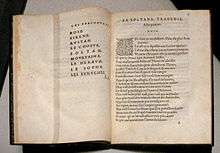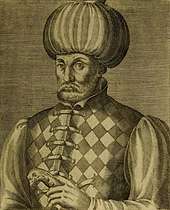Şehzade Mustafa
Şehzade Mustafa (Ottoman Turkish: شهزاده مصطفى; 6 August 1515 – 6 October 1553) was an Ottoman prince as the eldest son of Sultan Suleiman the Magnificent and his chief consort Mahidevran Sultan. He was the prince-governor of Manisa from 1533 to 1541, of Amasya from 1541 to 1549, and of Konya from 1549 to 1553. Şehzade Mustafa was the heir apparent to the Ottoman throne and an immensely popular prince among the army and the populace prior to his execution, by the order of his father Suleiman.
| Şehzade Mustafa | |
|---|---|
 An Ottoman miniature of Şehzade Mustafa | |
| Born | 6 August 1515 Manisa Palace, Manisa, Ottoman Empire |
| Died | 6 October 1553 Konya, Ottoman Empire (aged 38) |
| Burial | |
| Spouse | Fatma Handan Hatun Begüm Nurcihan Hatun |
| Issue | Şehzade Süleyman Şehzade Ahmed Şehzade Mehmed Fatma Sultan Raziye Sultan |
| Dynasty | Ottoman |
| Father | Suleiman the Magnificent |
| Mother | Mahidevran Sultan |
| Religion | Islam |
Life

Şehzade Mustafa was born on 6 August 1515 in Manisa to Şehzade Suleiman (the future sultan) and Mahidevran.
Mustafa experienced some problems in his relationship with his father since his early years. Though he was the first of Suleiman's sons to survive childhood and the most potential heir, his father was interested in Mustafa's younger half-brother, Şehzade Mehmed, the eldest son of Hürrem Sultan, the most prominent of Suleiman's consorts and later his legal wife.
Mustafa is thought to have been very close to his half-brothers Mehmed (born 1521), Selim (born 1524), Bayezid (born 1525), and Cihangir (born 1531), exemplified by the fact that Selim treated Mahidevran like his own mother by giving her back her wealth and helping to build Mustafa’s türbe in Bursa. However, a true scale of their relationship is not completely known. And due to the rules of fratricide, it would have been difficult for them to have a close relationship.
Then, in 1541, he faced a second shock after being sent to Amasya from the more prominent Manisa; the rule of Manisa was given to Mehmed, while Şehzade Selim and Şehzade Bayezid were sent to Konya and Kütahya for their sanjak assignments. However, after he was sent to Amasya, Mustafa got the news of an edict written by Suleiman: he had sent him to Amasya not because he did not want him to be his heir, but to defend the eastern part of Anatolia and learn how to manage a large empire.[1] This relieved the Ottoman army and the people of Anatolia, as Şehzade Mustafa was the popular successor to the throne.
In Amasya, he got the news of the death of his brother Mehmed on 6 November 1543. It seemed like all barriers between the throne and Mustafa were gone, but he still faced another challenge. Selim was sent from Konya to Manisa in 1544, while Şehzade Bayezid remained in Kütahya. It was a critical decision, as they were Hürrem's sons, the mother of the late Mehmed. Hürrem's support of her own sons made Mustafa's political career difficult, but he successfully ruled Amasya for 8 years.
In 1547, during Suleiman's Elkas Campaign, the sultan met with his sons Selim, Bayezid, and Mustafa in different locations to discuss the political situation. It was well after the death of Mehmed, but the competition between the three princes was still going on.
In 1549, as a reward for his excellent participation in the Ottoman-Safavid War, Mustafa moved to Konya for his sanjak assignment.[2] The rumours and speculations say that Mustafa's life was now in danger, as Hürrem and Rüstem Pasha had made a court alliance against him in favor of Hürrem's sons, Selim and Bayezid.
Execution

During Suleiman's Persian campaign, his army halted in Ereğli for a while. While Suleiman's army was in Ereğli, Rüstem Pasha made an offer to Mustafa to join his father's army. At the same time he warned Suleiman and persuaded him that Mustafa was coming to kill him.[3]
Mustafa accepted Rüstem Pasha's offer and assembled his army to join his father's. Suleiman saw this as a threat and ordered the execution of his son. When Mustafa entered his father's tent to meet with him, Suleiman's guards attacked Mustafa, and after a long struggle they killed him using a bow-string. The name of the man who strangled Şehzade Mustafa was Mahmut Ağa. He was Rüstem Pasha's right hand.[4]
After the death of the prince, the Janissaries and Anatolian soldiers of Mustafa rebelled against Suleiman's decision. The Janissaries supported Mustafa because of Ottoman traditions about succession and the success of Mustafa as a warrior.
The people blamed Suleiman's wife Hürrem and his son-in-law Rüstem, and even the Sultan himself for this unfair execution. After the protests of the army, Suleiman dismissed Rüstem from his position as Grand Vizier and sent him back to Istanbul. Hürrem is usually held at least partly responsible for the intrigues in nominating a successor to the throne, though there is no evidence to support this.[5]
Suleiman ordered that Mustafa be given a state funeral in Istanbul. After a week lying in state at Hagia Sophia, Mustafa was laid to rest in a large mausoleum in Bursa. Mustafa's execution caused unrest in Anatolia, especially in Amasya, Manisa and Konya, because the people saw him as the next sultan and because of his generosity and braveness. The poet Taşlıcalı Yahya composed an elegy for the dead prince. His story was similar to the story of Sultan Cem.
Family
- Consorts
Mustafa had two consorts:
- Fatma Handan Hatun (buried in Üçhanım Kızlar Mausoleum, Bursa);[6]
- Begüm Nurcihan Hatun (buried in Üçhanım Kızlar Mausoleum, Bursa);[6]
- Sons
Mustafa had three sons:
- Şehzade Süleyman Çelebi (buried in Şehzadeler Mausoleum, Amasya);[7]
- Şehzade Ahmed (buried in Turgutoğlu Mausoleum, Konya);[8]
- Şehzade Mehmed (1546, Amasya[9] – killed May 1554, Bursa, buried in Şehzade Mustafa Mausoleum, Muradiye Complex, Bursa);[10][11]
- Daughters
Mustafa had two daughters:
- Fatma Sultan (died in Istanbul), married to Maktul Ahmed Pasha, governor of Rumelia Eyalet;[7]
- Raziye Sultan (died in Istanbul);[7]
Depictions in literature and popular culture

In 1561, eight years after Mustafa's death, the French author Gabriel Bounin wrote a tragedy titled La Soltane about the role of Hürrem Sultan in Mustafa's death.[12] This tragedy marks the first time the Ottomans were introduced on stage in France.[13]
In the television series Muhteşem Yüzyıl, Mustafa is played by Turkish actor Mehmet Günsür.
| Wikimedia Commons has media related to Bursa Şehzade Mustafa Türbesi. |
References
- Afyoncu, Erhan (2012). Şehzade Mustafa. Atlas Tarih.
- Sakaoğlu, Necdet; Bu Mülkün Sultanları, page 137.
- Beosch, Moritz. The Height of the Ottoman Power; Murder of Prince Mustafa
- A General History of the Middle East, Chapter 13: Ottoman Era, Suleiman the Magnificent
- Peirce, Leslie P. (1993). The Imperial Harem: Women and Sovereignty in the Ottoman Empire. Oxford University Press. p. 60. ISBN 0-19-508677-5.
- Eğri, Sadettin (2016). Mahidevran (Gülbahar) Sultan Ve Itiknâmesi. pp. 50 n. 10.
- Hüsameddin, Hüseyin (1927). Amasya Tarihi, Volume III. Istanbul. p. 311.
- Konyalı, İbrahim Hakkı (2007). Konya Tahihi. Konya. p. 280.
- Arıkan, Zeki (December 1, 1990). Osmanlı Araştırmaları X: Manisa'nın 1 Numaralı Şer'iyye Sicilindeki Osmanlı Tarihi. p. 125.
- Demirtaş, Funda (2010). Şehzade Mustafa’nın Öldürülmesi -Tahlilî Bir Yaklaşım-. Bilimname. p. 217.
- Keskin, Mustafa Çağhan (2015). Ömüm Sanaat Malân V: Gecikmiş Bir İade-i İtibar: Şehzade Mustafa Türbesi (Merkad-i Gülzar-ı Sultan Mustafa). Özgür Öztürk Dakam Yahınları. p. 255. ISBN 978-6-059-20711-9.
- The Literature of the French Renaissance by Arthur Augustus Tilley, p.87
- The Penny cyclopædia of the Society for the Diffusion of Useful Knowledge p.418
